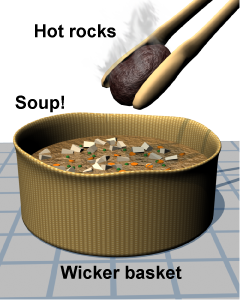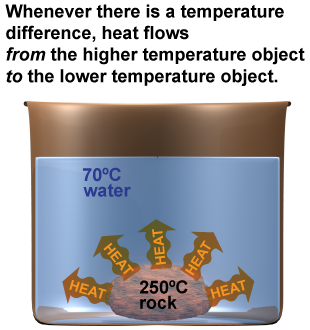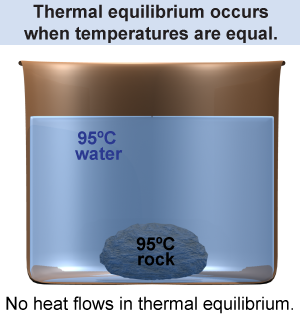|
 Can you think of a way to cook soup on a campfire with only a wooden or wicker pot? The secret is to use fire-heated rocks to transfer heat. In fact, the children’s story Stone Soup was inspired by the real traditional practice of using hot stones to boil water. Using this technique, Native Americans and other ancient peoples cooked soups and stews in water-tight wicker baskets! This is quite clever because a wicker basket would never survive being heated directly by a fire. Think about the flow of thermal energy, or heat, that occurs when you drop a hot rock in a container of cold water.
Can you think of a way to cook soup on a campfire with only a wooden or wicker pot? The secret is to use fire-heated rocks to transfer heat. In fact, the children’s story Stone Soup was inspired by the real traditional practice of using hot stones to boil water. Using this technique, Native Americans and other ancient peoples cooked soups and stews in water-tight wicker baskets! This is quite clever because a wicker basket would never survive being heated directly by a fire. Think about the flow of thermal energy, or heat, that occurs when you drop a hot rock in a container of cold water. - How does the temperature of the rock change?
- How does the temperature of the water change?
- How do the two temperatures compare after some time has passed?

|
Thermal equilibrium
|
 Whenever two objects are at different temperatures, heat will flow from the higher temperature object to the lower temperature object. The same is true for different areas of the same object. Heat naturally flows from regions of higher temperature to regions of lower temperature. In the example of boiling water with hot stones, thermal energy flows out of a hot stone and into the cold water instead of the other way around. The fact that heat flows from hot to cold is the most common consequence of the second law of thermodynamics, the law that governs the flow of energy in real systems.
Whenever two objects are at different temperatures, heat will flow from the higher temperature object to the lower temperature object. The same is true for different areas of the same object. Heat naturally flows from regions of higher temperature to regions of lower temperature. In the example of boiling water with hot stones, thermal energy flows out of a hot stone and into the cold water instead of the other way around. The fact that heat flows from hot to cold is the most common consequence of the second law of thermodynamics, the law that governs the flow of energy in real systems. 
|
 Heat continues to flow until all objects are at the same temperature. The condition in which everything is at the same temperature is called thermal equilibrium. In thermal equilibrium, no heat flows because the temperatures are the same. For example, if hot rocks are immersed in cold water, thermal equilibrium occurs once both the rocks and the water reach the same temperature. Of course, unless the air is at the same temperature, heat will still flow between the pot and the air! This heat flow is why hot objects cool down.
Heat continues to flow until all objects are at the same temperature. The condition in which everything is at the same temperature is called thermal equilibrium. In thermal equilibrium, no heat flows because the temperatures are the same. For example, if hot rocks are immersed in cold water, thermal equilibrium occurs once both the rocks and the water reach the same temperature. Of course, unless the air is at the same temperature, heat will still flow between the pot and the air! This heat flow is why hot objects cool down. 
|
When the hot rock is placed in the cold water, does the water heat up instantaneously? Of course not! It usually takes some time for two objects to reach thermal equilibrium. The rate that two objects come into thermal equilibrium is discussed on the next page. 
|
- A brick is resting in a pan of water on a table. The brick has a temperature of 21ºC, the air has a temperature of 37ºC, and the water has a temperature of 27ºC. Which of the following is not true?
- Heat flows from the brick into the water.
- Heat flows from the air into the water.
- Heat flows from the air into the brick.
- Heat flows from the water into the brick.
 |
Statement a is not true. The brick has a lower temperature than the water, so heat flows from the 27ºC water into the 21ºC brick and not the other way around. 
|

